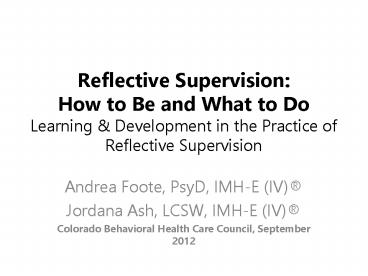Reflective Supervision: How to Be and What to Do Learning
Title:
Reflective Supervision: How to Be and What to Do Learning
Description:
Reflective Supervision: How to Be and What to Do Learning & Development in the Practice of Reflective Supervision Andrea Foote, PsyD, IMH-E (IV) –
Number of Views:553
Avg rating:3.0/5.0
Title: Reflective Supervision: How to Be and What to Do Learning
1
Reflective Supervision How to Be and What to
DoLearning Development in the Practice of
Reflective Supervision
- Andrea Foote, PsyD, IMH-E (IV)
- Jordana Ash, LCSW, IMH-E (IV)
- Colorado Behavioral Health Care Council,
September 2012
2
Whyd we start this way?
- Reflective practice is cornerstone of clinical
practice for administration, supervisors,
clinicians, other practitioners. - Without it we are acting without full awareness
of the vast majority of information and
communication available to us - Mindfulness and self awareness can be seen as the
foundation for the reflective relationship - Reflection as the foundation for safety learning
3
Plan for today
- Explore the concepts foundations of reflective
supervision - Links to Triple Aim
- Administrative, clinical reflective supervision
- Small group discussion
- BREAK (400-415 ish)
- How do you know its working?
- Dyadic Experience
- Wrap up
4
Video
5
Definition
- Reflective supervision is an ongoing
communication process that regulates and
understands the flow of emotion, information and
experience. - Reflective supervision occurs between two or more
individuals whereby the developing relationships
serve as the vehicle for acceptance, trust and
respect and a mindful service delivery - The supervisor is a trained, skillful and
experienced professional who creates a safe space
from which a supervisee can learn and reflect
about their work. - Janet Dean, LCSW
- 2010
6
How to be What to doKey Concepts in Reflective
Supervision
- Regularity
- Consistent meeting time
- No interruptions
- Slowing down
- Containment
- Partnering with supervisee to regulate anxiety
emotions - Serves the purpose of being able to reflect
rather than react - Remembering what was brought before
7
How to be What to doKey Concepts in Reflective
Supervision
- Inquiry
- Curiosity
- Embracing complexity
- Wondering together tolerating now knowing
- Cultural Considerations of the work
- Direct advocacy teaching, not just process
- Reflection
- Bringing awareness
- Paying close attention to the supervisees
thoughts, feelings distractions - Experiences finding ones own answers
- Exploring whats missing ?
8
How to be What to doKey Concepts in Reflective
Supervision
- Reciprocity and Collaboration
- Jointly setting the agenda
- Trust that what comes forward is what needs to be
looked at - Emotionally available supervisor/ emotionally
open supervisee - Parallel Process
- What happens between supervisor supervisee is
information about what is happening for
supervisee client, and client child.
9
Safety Learning in Reflective Supervision
- A nurse's perspective
10
Safety Learning in Reflective Supervision
- Foundation for dealing with vicarious trauma,
reducing burnout, fighting turnover - Insurance policy practitioners are aware of
whats being acted out non-consciously or through
lack of awareness with clients
Enactment is our
unresolved behavior patterns acted out - Pays off administratively and clinically.
11
Critical Distinctions or A Relationship for All
Kinds of Learning
- Administrative
- Performance Evaluations
- Productivity
- Agency/Organizational Expectations
- Clinical
- Case formulation
- Diagnosis and Treatment Goals
- Transference Counter-transference
- Reflective
12
Compelling Forces
- Reflective supervision strives to continuously
integrate compelling forces such as reflection
and direct advocacy. - The provision of attuned guidance is measured by
the need to stay in inquiry.
13
Table Talk Conversation
- What is your current experience with reflective
supervision in your organization or practice? - What aspects of a RS practice would be most
challenging to implement? - Which messages about RS would resonate most in
your organization?
14
Break
15
Supporting Reflective Supervision why should
agencies organizations invest?
- Whats the research out there?
- Impacts of physical health
- Minimizing effects vicarious trauma
- In children adults , increased self-regulation
- Connection community and family supports
- Staff retention/ staff morale
- Knowledgeable and effective practitioners
16
What might it take?
- Video
17
Some Practice Considerations
- Group
- Community Infant Program Model/adapted from NCTSN
- Anxieties inadequacies minimized
- Increases relational capacity
- Team resilience
- Peer
- Facilitated/non-facilitated
- Small cluster
- Case consultation
- Consulting to a Clinical Team
- Promoting a team culture
- Job descriptions/interviews
- New employees
18
Todays Reflection Supervision Experience
- Confidentiality
- Respect of each others process and starting
place - Heighten your awareness around how you are with
another in a supervisory 11 interaction - Notice your own tendencies
- _________________
- Each person will practice each role
- About 10 minutes a turn (we will let you know)
19
RS Experience Reflections
- Getting centered
- What did you notice?
- How did that feel/ compare to other supervisory
experiences? - How might this kind of supervision support your
work? - What else do you need to know?
20
Resources
- Reflective Supervision Rating Scale
- Informing agency practice
- Introduction to new supervisees
- Quality Checks
- Research
- Resource List
- CoAIMH Teach-In (www.coaimh.org)
21
Wrap up
- How to be What to do
- Q A
- Whats next for RS
- Some last thoughts
- Jordana Ash jash_at_mhpcolorado.org
- Andrea Foote afoote_at_mhpcolorado.org

